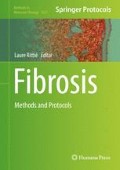Abstract
Cells with mesenchymal stem cell characteristics can be isolated from human adipose tissue stroma. Relative ease of isolation in large numbers and their ability for expansion and differentiation means that they are becoming a preferred cell type for mesenchymal regenerative medicine applications. In addition to expansion and differentiation capacity, they also express valuable paracrine activities which promote tissue formation and wound healing, including pro- and anti-fibrotic mediators. Here we describe a method for routine isolation of adipose stromal cells, culture expansion, and characterization by differentiation and then production of conditioned media.
Access this chapter
Tax calculation will be finalised at checkout
Purchases are for personal use only
References
Zuk PA, Zhu M, Mizuno H et al (2001) Multilineage cells from human adipose tissue: implications for cell-based therapies. Tissue Eng 7(2):211–228. doi:10.1089/107632701300062859
Zuk PA, Zhu M, Ashjian P et al (2002) Human adipose tissue is a source of multipotent stem cells. Mol Biol Cell 13(12):4279–4295. doi:10.1091/mbc.E02-02-0105
Dominici M, Le Blanc K, Mueller I et al (2006) Minimal criteria for defining multipotent mesenchymal stromal cells. The International Society for Cellular Therapy position statement. Cytotherapy 8(4):315–317. doi:10.1080/14653240600855905
Friedenstein AJ, Deriglasova UF, Kulagina NN et al (1974) Precursors for fibroblasts in different populations of hematopoietic cells as detected by the in vitro colony assay method. Exp Hematol 2(2):83–92
Katz AJ, Tholpady A, Tholpady SS et al (2005) Cell surface and transcriptional characterization of human adipose-derived adherent stromal (hADAS) cells. Stem Cells 23(3):412–423. doi:10.1634/stemcells.2004-0021
Moon MH, Kim SY, Kim YJ et al (2006) Human adipose tissue-derived mesenchymal stem cells improve postnatal neovascularization in a mouse model of hindlimb ischemia. Cell Physiol Biochem 17(5–6):279–290. doi:10.1159/000094140
Hsiao ST, Asgari A, Lokmic Z et al (2012) Comparative analysis of paracrine factor expression in human adult mesenchymal stem cells derived from bone marrow, adipose, and dermal tissue. Stem Cells Dev 21(12):2189–2203. doi:10.1089/scd.2011.0674
Matsuda K, Falkenberg KJ, Woods AA et al (2013) Adipose-derived stem cells promote angiogenesis and tissue formation for in vivo tissue engineering. Tissue Eng Part A 19(11–12):1327–1335. doi:10.1089/ten.TEA.2012.0391
Ebrahimian TG, Pouzoulet F, Squiban C et al (2009) Cell therapy based on adipose tissue-derived stromal cells promotes physiological and pathological wound healing. Arterioscler Thromb Vasc Biol 29(4):503–510. doi:10.1161/ATVBAHA.108.178962
Le Blanc K, Ringden O (2006) Mesenchymal stem cells: properties and role in clinical bone marrow transplantation. Curr Opin Immunol 18(5):586–591. doi:10.1016/j.coi.2006.07.004
Mazo M, Planat-Benard V, Abizanda G et al (2008) Transplantation of adipose derived stromal cells is associated with functional improvement in a rat model of chronic myocardial infarction. Eur J Heart Fail 10(5):454–462. doi:10.1016/j.ejheart.2008.03.017
Colazzo F, Sarathchandra P, Smolenski RT et al (2011) Extracellular matrix production by adipose-derived stem cells: implications for heart valve tissue engineering. Biomaterials 32(1):119–127. doi:10.1016/j.biomaterials.2010.09.003
Kim WS, Park BS, Sung JH et al (2007) Wound healing effect of adipose-derived stem cells: a critical role of secretory factors on human dermal fibroblasts. J Dermatol Sci 48(1):15–24. doi:10.1016/j.jdermsci.2007.05.018
Author information
Authors and Affiliations
Corresponding author
Editor information
Editors and Affiliations
Rights and permissions
Copyright information
© 2017 Springer Science+Business Media LLC
About this protocol
Cite this protocol
Liew, L.J., Ong, H.T., Dilley, R.J. (2017). Isolation and Culture of Adipose-Derived Stromal Cells from Subcutaneous Fat. In: Rittié, L. (eds) Fibrosis. Methods in Molecular Biology, vol 1627. Humana Press, New York, NY. https://doi.org/10.1007/978-1-4939-7113-8_12
Download citation
DOI: https://doi.org/10.1007/978-1-4939-7113-8_12
Published:
Publisher Name: Humana Press, New York, NY
Print ISBN: 978-1-4939-7112-1
Online ISBN: 978-1-4939-7113-8
eBook Packages: Springer Protocols

